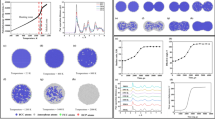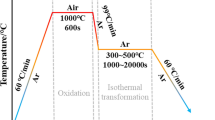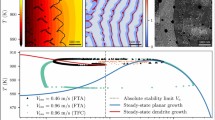Abstract
The concept and theoretical basis of the three-component zone melting method is given for growing single crystals of semiconductor solid solutions using seeds from constituent components. In the Pfann approximation, the problem of the axial concentration distribution of components in Ge–Si single crystals grown at different values of the operating parameters such as the length of the melted zone and the composition of the initial macrohomogeneous rods of solid solutions is solved. Analysis of the obtained results determines the potentialities of the method and the optimal conditions for growing single crystals with given homogeneous and graded compositions in the entire continuous series of Ge–Si solid solutions. It is shown that the three-component zone-melting method is promising for the growth of single crystals of semiconductor solid solutions.



Similar content being viewed by others
REFERENCES
J. Schilz and V. N. Romanenko, J. Mater. Sci.: Mater. Electron. 6, 265 (1995).
A. Barz, P. Dold, U. Kerat, S. Recha, K. W. Benz, M. Franz, and K. Pressel, J. Vac. Sci. Technol. B 16, 1627 (1998).
C. Marin and A. G. Ostrogorsky, J. Cryst. Growth 211, 378 (2000).
S. Adachi, J. Cryst. Growth 280, 372 (2005).
T. A. Campbell, M. Schweizer, P. Dold, A. Cröll, and K. W. Benz, J. Cryst. Growth 226, 231 (2001).
G. Kh. Azhdarov, Z. M. Zeynalov, Z. A. Agamaliyev, and A. I. Kyazimova, Crystallogr. Rep. 55, 716 (2010).
A. Varilci, T. Kucukomeroglu, and G. Kh. Azhdarov, Chin. J. Phys. 41, 79 (2003).
G. Kh. Azhdarov, T. Kucukomeroglu, A. Varilci, M. Altunbaş, A. Kobya, and P. G. Azhdarov, J. Cryst. Growth 226, 437 (2001).
N. V. Abrosimov, S. N. Rossolenko, W. Thieme, A. Gerhardt, and W. Schroder, J. Cryst. Growth 174, 182 (1997).
I. Yonenaga, J. Cryst. Growth 275, 91 (2005).
V. K. Kyazimova, Z. M. Zeynalov, Z. M. Zakhrabekova, and G. Kh. Azhdarov, Crystallogr. Rep. 51, 192 (2006).
G. Kh. Azhdarov, Z. M. Zeynalov, and L. A. Huseynli, Crystallogr. Rep. 54, 152 (2009).
I. Yonenaga and T. Ayuzava, J. Cryst. Growth 297, 14 (2006).
P. Dold, A. Barz, S. Recha, K. Presse, M. Franzb, and K. W. Benza, J. Cryst. Growth 192, 125 (1998).
Z. M. Zakhrabekova, Z. M. Zeinalov, V. K. Kyazimova, and G. Kh. Azhdarov, Inorg. Mater. 43, 3 (2007).
S. Bok-Cheol, K. Kwang, and L. Hong-Woo, J. Cryst. Growth 290, 665 (2006).
G. Kh. Azhdarov, Z. A. Agamaliev, and E. M. Islamzade, Crystallogr. Rep. 59, 442 (2014).
Z. A. Agamaliyev, E. M. Islamzade, and G. Kh. Azhdarov, Crystallogr. Rep. 61, 327 (2016).
M. Yildiz, S. Dost, and B. Lent, J. Cryst. Growth 280, 151 (2005).
K. Nakajima, T. Kusunoki, Y. Azuma, N. Usami, K. Fujiwara, T. Ujihara, G. Sazaki, and T. Shishido, J. Cryst. Growth 240, 373 (2002).
V. M. Glazov and V. S. Zemskov, Physicochemical Bases of Semiconductor Doping (Nauka, Moscow, 1967) [in Russian].
I. Yonenaga, J. Cryst. Growth 198–199, 404 (1999).
P. G. Azhdarov and N. A. Agaev, Inorg. Mater. 35, 763 (1999).
I. Kostylev, J. K. Woodaste, Y. P. Lee, P. Klages, and D. Labrie, J. Cryst. Growth 377, 147 (2013).
Author information
Authors and Affiliations
Corresponding author
Ethics declarations
The author declares no conflicts of interest.
Additional information
Translated by V. Bukhanov
Rights and permissions
About this article
Cite this article
Aghamaliyev, Z.A. Three-Component Zone-Melting Method: Modeling of the Concentration-Component Distribution in Single Crystals of Ge–Si Solid Solutions. Semiconductors 55, 283–288 (2021). https://doi.org/10.1134/S1063782621020032
Received:
Revised:
Accepted:
Published:
Issue Date:
DOI: https://doi.org/10.1134/S1063782621020032




